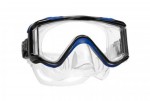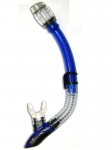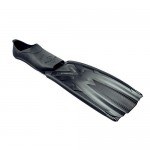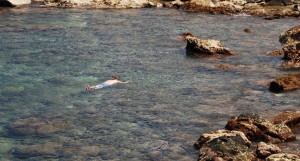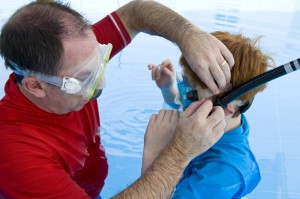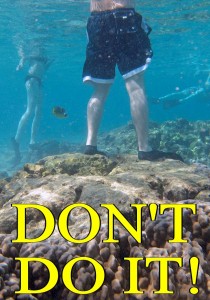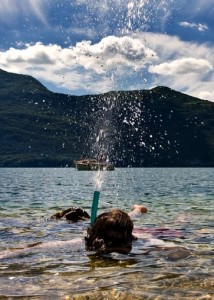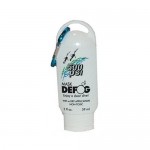 The ocean provides an abundance of beauty and fun for all, but go under the surface – even a few inches – and you enter a whole new world of underwater ocean life! Snorkeling allows you a sneak peak of what lies beneath the ocean’s surface – eye candy full of colorful coral reefs, green sea turtles, starfish and the hundreds of fish in Hawaii’s waters. Snorkeling is fun because almost anyone can do it right from the beachfront or take a boat and snorkel in the middle of the ocean. Be adventurous and snorkel with some friends or join a snorkel tour! There is also the opportunity to snorkel during the night, which can be very rewarding due to the numerous nocturnal creatures that you can discover. Increasingly, snorkeling has become one of the most popular ocean activities for family enjoyment.
The ocean provides an abundance of beauty and fun for all, but go under the surface – even a few inches – and you enter a whole new world of underwater ocean life! Snorkeling allows you a sneak peak of what lies beneath the ocean’s surface – eye candy full of colorful coral reefs, green sea turtles, starfish and the hundreds of fish in Hawaii’s waters. Snorkeling is fun because almost anyone can do it right from the beachfront or take a boat and snorkel in the middle of the ocean. Be adventurous and snorkel with some friends or join a snorkel tour! There is also the opportunity to snorkel during the night, which can be very rewarding due to the numerous nocturnal creatures that you can discover. Increasingly, snorkeling has become one of the most popular ocean activities for family enjoyment.
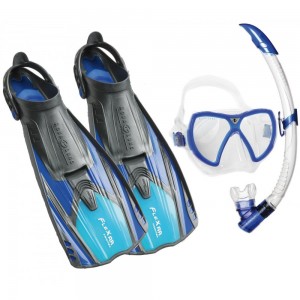
Getting Started
Choosing your gear is very important. We don’t recommend the cheap snorkel set found at the trinkets store. Try to budget yourself at least $60.00 for your mask, snorkel and fins – and buy from a snorkel or scuba retailer. This will get you an entry-level starter set. A cheap setup will not last long, will probably be used for only one trip, most likely won’t fit well, and just as well could leak. If you don’t want to buy your snorkel gear, try renting as this might be the better option.
Mask
When you are ready to buy or rent, take the time and try on many different masks to find a good fit. Not all peoples’ heads are shaped the same and choosing the wrong mask could result in too much pressure on parts of your face, an all-day headache, and/or water leaks. The best way to test a mask is to move the strap out of the way and push the mask gently onto your face with your thumbs holding the side skirting back, then breathe in through your nose. If the mask stays on by itself, and there is no light coming through, it has a good seal. After you have checked the seal, push the mask firmly on your face to check for discomfort areas. If you feel pressure on the cheeks, nose, eye sockets or eyebrows, it might lead to pain and headaches after snorkeling for a while.
Also play around with the straps and see if you are comfortable adjusting the length as this is important when you are in the water. Many masks have small side windows that increase peripheral viewing for a better experience and awareness of your surroundings. Masks with mirrored lenses will darken your view, but some people prefer this style because they believe the fish will be less fearful of you if they cannot see your eyes.
Snorkel
The snorkel (tube portion) allows you to breathe with your head underwater. There are different lengths and bore diameters. The optimal length is about 16” long. If its too short, then you will get water inside; too long and you are not circulating enough fresh air. The bore diameter for you may vary, ask your salesperson to help with this. When you breath in and out of the tube, there is a natural respiratory dead space, where you are breathing in some of the previously exhaled air. This will eventually lead to reduced breathing efficiency and a buildup of carbon dioxide in the blood. Additionally, choose a snorkel with a comfortable mouthpiece that fits nicely in your mouth. An uncomfortable mouth piece will lead to headaches and sore jaw muscles. The mouth piece should be held in your mouth without having to bite down too hard.
Some snorkels have a sump connected to the mouthpiece that will hold a small amount of water that gets into the snorkel and will not be inhaled. This is good because water will usually find its way into the open end of the snorkel. Some sumps have a one-way output valve that allows the water to drain. Most new snorkels have splash deflectors or float-operated valves at the open end of the snorkel that help prevent water from entering. See below about clearing the snorkel when water gets inside.
Fins
Some people say you don’t need fins but we recommend a pair because of the efficiency and speed that come with fins. You don’t have to go to the same extent in choosing your fins as you do choosing the mask and snorkel. If you can get your hands on a cheap set or even some hand-me-downs, its better than no fins at all. But if you are at the snorkel shop choosing a nice mask and snorkel set, you might as well try on a few different types of fins.
With most snorkel gear, the most important consideration is comfort – you don’t want to be half way through your snorkeling adventure and get chafing and blistering from your fins. Generally, stiffer fins are for scuba due to the increased weight with all the gear. Talk to your salesperson when deciding between open-foot vs. closed-foot and split-fin vs. paddle-fin. Booties are a must if using open-foot and dive socks can be worn with closed-foot to reduce chafing.
Never snorkel alone!
This cannot be overstressed! And this doesn’t mean going out with friends and then going your own way in the water. Many experts and lifeguards recommending staying within an arm length of your snorkeling buddy. In fact, try go in groups of three or more. Stay close to shore.
Getting in the water
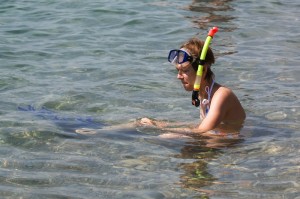 There are a few tips to remember when snorkeling, but the two most important are never snorkel alone, and become comfortable with your gear before getting in too deep. Some people get too anxious and want to get right to it. If you are not ready, this will only make your snorkeling adventure a little less fun. The best start for snorkeling is in shallow sandy water where you can sit down, or shallow enough where you can use your arms to push your body out of the water. Or if your hotel has a pool, practice there first. It’s a little clunky at first trying to maneuver with the long fins.
There are a few tips to remember when snorkeling, but the two most important are never snorkel alone, and become comfortable with your gear before getting in too deep. Some people get too anxious and want to get right to it. If you are not ready, this will only make your snorkeling adventure a little less fun. The best start for snorkeling is in shallow sandy water where you can sit down, or shallow enough where you can use your arms to push your body out of the water. Or if your hotel has a pool, practice there first. It’s a little clunky at first trying to maneuver with the long fins.
After you have this down, go out to deeper water and do the same steps. Also practice your flutter stroke with the fins. It can be quite uncomfortable trying to clear your mask and snorkel in deeper water with ocean water splashing you in the face, awkward fins and an unfamiliar rubber device strapped around your head. If your first experience with snorkeling is off a boat, stay near the ladder or netting while you familiarize yourself with the gear.
Take it easy
Snorkeling is a lot of fun, but don’t think its just a walk in the park. You will get tired. Take short trips and then go back to a safe place and take a breather. Don’t put yourself in a situation where you can’t relax for a while. If your legs become tired or if you get a cramp, take your mask and snorkel off and roll over onto your back. Slowly tread water with your arms and legs and relax. Some new snorkelers wear a life jacket or similar device for extra precaution. This is a great idea!
Be aware of your surroundings
Don’t just jump in! Look around and see whats going on around you. Know the area you are snorkeling and what areas to avoid. Look for breaking waves, shallow water and rocks to stay away from. Look where the groups are at and consider staying in those areas.
Snorkeling at what age?
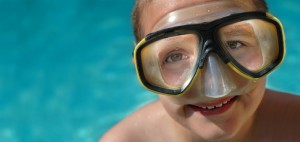 One of the great aspects of snorkeling is that pretty much the entire family can participate. If a child is too young to swim, it might be too early for them. Around age 5 is a good time to start experimenting but if you are going on a tour, ask about the minimum age requirement. We took our son out at age 3 with some standard swimmer’s goggles and a life jacket, and let him kick around in the shallow waters. As a parent, you need to decide what is best for your child. If they are experienced in the ocean and have been swimming for a while, they will probably be more ready do get in. If you are from a landlocked state our country, and your child has little or no experience in the ocean, they most likely are not ready at a young age. On the backside of life dealing with older folks, health is the biggest consideration. If there is any question, we recommend talking to your doctor to see if snorkeling is ok for you.
One of the great aspects of snorkeling is that pretty much the entire family can participate. If a child is too young to swim, it might be too early for them. Around age 5 is a good time to start experimenting but if you are going on a tour, ask about the minimum age requirement. We took our son out at age 3 with some standard swimmer’s goggles and a life jacket, and let him kick around in the shallow waters. As a parent, you need to decide what is best for your child. If they are experienced in the ocean and have been swimming for a while, they will probably be more ready do get in. If you are from a landlocked state our country, and your child has little or no experience in the ocean, they most likely are not ready at a young age. On the backside of life dealing with older folks, health is the biggest consideration. If there is any question, we recommend talking to your doctor to see if snorkeling is ok for you.
Control your body, arms and fins
The basic flutter stroke is the most common underwater kick – a very fast and efficient method of maneuvering in the water. Use a slow, comfortable pace and remember to keep your fins submerged in the water, don’t splash your fins above the water surface. Another common kick is the dolphin kick where both legs sweep up and down together, like a mermaid. This kick can be more difficult to master but is efficient and a good change of pace if your legs are tired. Keep your arms at your sides while swimming to reduce drag and prevent you from using them to push against a rock or touching something.
The ocean current will push and pull you and there is little you can do to control your body. You will soon find yourself in harmony with the ocean creatures that find this current quite normal. If the surge is pushing you toward a rock or coral, just be calm and allow a small amount of contact if you can’t avoid it. I would prefer to rub the side of my arm or shoulder than use my hand or fin to push away from a rock. Stay aware of your surroundings. Try not to touch anything including coral and ocean life.
Flooding and clearing the snorkel
For this article, we don’t recommend going beneath the surface if you are a beginner, so we don’t get into clearing when you are beneath the water. But you will inevitably get water into the snorkel and knowing how to clear the snorkel is very important. With blast clearing, slowly take in a deep breath and exhale very hard, and the water gets blasted out. You might have to do it a couple times. Its pretty easy, but if you have so much water that the snorkel won’t let you inhale, you have to bring your head up above the surface. Try tilting your head back or just take the snorkel out of your mouth and let it drain.
Care for your equipment
Clean all you gear after each snorkel trip. If you can, soak it in fresh water for a while. Either way, get all the salt crystals off, or it will eat your stuff fast! Let the gear dry and then store in a cool, dry place.
Mask fogging
Most new snorkel masks are made of silicone. This residue can rub off on the surface of the glass and has to be removed before getting in the water. Ask your salesperson about this as you don’t want to jeopardize your warranty. Some people recommend gently rubbing toothpaste to get the initial film off. Either way, get it off or you will have more fogging issues.
Its hard to avoid fogging no matter what preventative actions you take. The first line of defense is to keep the glass clean with mild soap and water. There are various defogging solutions available on the market that you can apply before you get in the water. If you are in the water and get fogging, the first step is to go above the surface, slightly remove the mask and allow some water to splash around inside, and then drain it. If that doesn’t work, spit some saliva (not a loogie) in there are rub it around with your fingers.
